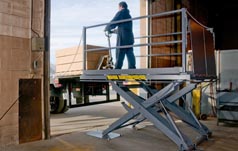 As part of any business to keep your employees safe and to keep business running as usual, maintaining your loading dock equipment is vital to this continual operation. Depending on your individual application, your loading dock equipment may include truck restraints, dock levelers, and roll up doors – all of which are intricate parts of the loading dock. If you have an outside maintenance program – all the better, but small things can happen and you can’t always wait for their inspection appointment. Developing an in-house, on-site inspection program will keep your loading dock equipment working; and give you early warning signs of problems.
As part of any business to keep your employees safe and to keep business running as usual, maintaining your loading dock equipment is vital to this continual operation. Depending on your individual application, your loading dock equipment may include truck restraints, dock levelers, and roll up doors – all of which are intricate parts of the loading dock. If you have an outside maintenance program – all the better, but small things can happen and you can’t always wait for their inspection appointment. Developing an in-house, on-site inspection program will keep your loading dock equipment working; and give you early warning signs of problems.
In-house on-site inspections
Safety and operation are very important to keep your loading dock equipment in the best working order by developing a routine for inspecting:
- Operation: Run your equipment through its process, listening for strange noises or vibrations.
- Visual: Look for usual damage, look at welded spots for weaknesses, check safety labels, loose fasteners, etc.
- Fluid Levels: check fluid levels from time to time.
- Lubrication: Hinges, pins, and pivot points need to be well lubricated.
Clean the area from debris so that it does not interfere with the mechanism, and schedule maintenance depending on the traffic.
In-house inspections are only part of the maintenance of your loading dock equipment and should be conducted, depending on traffic, from monthly to three or four times a year – and maintain a log. Check the manual for their suggestions on inspections, lubrications and fluid levels.
Professional inspections
Your dock equipment will also require professional inspections and these are much more detailed. Each piece will need to be cleaned and or adjusted. This should involve checking each part beyond the visuals. They will physically check:
- Assemblies and releases
- Sensors and seals
- Chains, bolts, sprints, welds, hinges, pins
- Frame and subframe
- Sensory and alignment
- Hydraulic cylinder
The professional maintenance should also include:
- Adjustments – to ensure the equipment runs smoothly and consistently.
- Clean – to prevent dirt and debris from jamming and causing premature wear.
- Inspections – looking for future problems.
- Lubrication – to components for protection from wear, corrosion and moisture.
Loading dock equipment is a valuable part of your loading dock and warehouse and they must be kept running efficiently and safely. Inspecting your equipment should be included in the protection and upkeep – it’s in the best interest of your business. It is also in your best interest to train your employees in safe practices and to provide them with safe working equipment.

